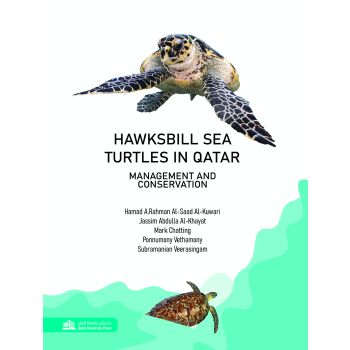Hawksbill Sea Turtles in Qatar Management and Conservation
Hawksbill turtles are classified as "Critically Endangered" by the International Union for the Conservation of Nature due to global population declines, primarily caused by fishery by-catch and habitat destruction. In Qatar, hawksbill turtles play a crucial role in maintaining marine biodiversity, particularly in coral habitats and seagrass beds. Qatar initiated sea turtle protection efforts in 2002, contributing to global conservation through a long-term project with the Environmental Science Center of Qatar University, Ministry of Environment & Climate Change, and QatarEnergy. The datasets generated by ESC include environmental conditions at the nesting locations, hatching success rates as a result of clutch relocation, incubation duration, reproductive outputs, satellite tracking, predation by foxes and birds and mortality due to anthropogenic activities. These data help to frame conservation initiatives. Various conservation actions such as creation of marine protected areas, beach protection, and development of bycatch regulations are presently being applied to the hawksbill sea turtle in Qatar, and they are positively impacting the hawksbill sea turtle populations. Overall, Qatar's conservation initiatives aim to secure the future of hawksbill turtles and contribute to global efforts for sea turtle preservation.
صُنّفت سلاحف منقار الصقر من قبل الاتحاد الدولي لحفظ الطبيعة على أنها "مهددة بالانقراض بشدة"، بسبب انخفاض أعدادها حول العالم، ويعود السبب في المقام الأول إلى الصيد العرضي وتدمير الموائل. وفي قطر، تلعب السلاحف صقرية المنقار دورًا حاسمًا في الحفاظ على التنوع البيولوجي البحري، لا سيما في الموائل المرجانية وأحواض الأعشاب البحرية. بدأت قطر جهود حماية السلاحف البحرية في عام 2002، حيث أسهمت في الحفاظ عليها عالميًا من خلال مشروعٍ طويل الأمد بتعاون بين مركز العلوم البيئية بجامعة قطر، ووزارة البيئة والتغير المناخي، وقطر للطاقة. تتضمن قاعدة البيانات التي أنشأها مركز العلوم البيئية الظروف البيئية في مواقع التعشيش، ومعدلات نجاح الفقس نتيجة لنقل حضنة البيض، ومدة الحضانة، والمخرجات الإنجابية، وتتبع الأقمار الصناعية، وافتراس الثعالب والطيور والوفيات الناجمة عن الأنشطة البشرية. تساعد تلك البيانات في صياغة مبادرات الحماية. ويجري حاليًا تطبيق العديد من إجراءات الحماية، مثل إقامة مناطق بحرية محمية، وحماية الشواطئ، وتطوير أنظمة الصيد العرضي على السلاحف البحرية صقرية المنقار في قطر، بما يؤثر بشكل إيجابي على أعداد السلاحف البحرية صقرية المنقار. بشكل عام، تهدف مبادرات الحفاظ على البيئة في قطر إلى تأمين مستقبل السلاحف صقرية المنقار، والإسهام في الجهود العالمية للحفاظ على السلاحف البحرية.

